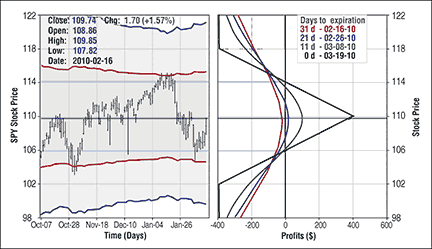OPTIONS
Unique Options
The Out-Of-The-Money Butterfly Spread
This option trading strategy gives you a favorable reward-to-risk ratio and a wide profit range.
The primary reason investors and traders are drawn to option trading is the ability to enter into unique positions to take advantage of unusual opportunities that they would otherwise not be able to, simply by trading the underlying security. If you buy 100 shares of a given stock, you make $100 for each point it rises in price and you lose $100 for each point it declines in price. There are no exceptions to this rule.
On the other hand, using options makes it possible to craft a position that will profit based on a specific expected scenario. You can create a position that will make money if the stock goes up, another if the stock goes down, yet another if the stock goes up or down a lot, and another still that will profit if the stock simply stays within a narrow range. And there are more possibilities. Thus, it is not surprising that interest in option trading continues to grow. The key to achieving long-term success in options is to know what opportunities exist and acquire the knowledge necessary to be able to exploit them.
Here, I will detail an option trading strategy that most traders have never considered — the out-of-the-money (Otm) butterfly spread. This strategy can offer the trader a limited-risk method to enter into a trade with an extremely favorable reward-to-risk ratio while offering a wide range of profitability. Still, before attempting to grasp the concept of the Otm butterfly spread, you should have an understanding of a standard at-the-money butterfly spread. So that’s where we’ll start.

Figure 1: Risk Curves for a Standard Neutral Butterfly Spread. For this trade you are selling the at-the-money call (or put) and buying a higher and lower strike price call (or put). Entering into this position established a range of profitability with two breakeven prices, one above and one below the current price of the underlying securities.